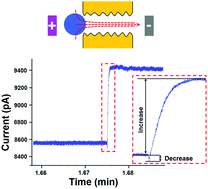Probing charges on solid–liquid interfaces with the resistive-pulse technique†
Abstract
Our manuscript addresses the issue of probing an effective surface charge that any surface can acquire at the solid/liquid interface. Even if a particle is predicted to be neutral based on its chemical structure, the particle can carry finite surface charges when placed in a solution. We present tools to probe the presence of surface charge densities of meso-particles, characterized with zeta potentials below 10 mV. The tools are based on the resistive-pulse technique, which uses single pores to probe properties of individual objects including molecules, particles, and cells. The presented experiments were performed with particles 280 and 400 nm in diameter and single pores with opening diameter tuned between ∼ 200 nm and one micron. Surface charge properties were probed in two modes: (i) the passage of the particles through pores of diameters larger than the particles, as well as (ii) an approach curve of a particle to a pore that is smaller than the particle diameter. The curve in the latter mode has a biphasic character starting with a low-amplitude current decrease, followed by a current enhancement reaching an amplitude of ∼10% of the baseline current. The current increase was long-lasting and stable, and shown to strongly depend on the particle surface charge density. The results are explained via voltage-modulation of ionic concentrations in the pore.



 Please wait while we load your content...
Please wait while we load your content...